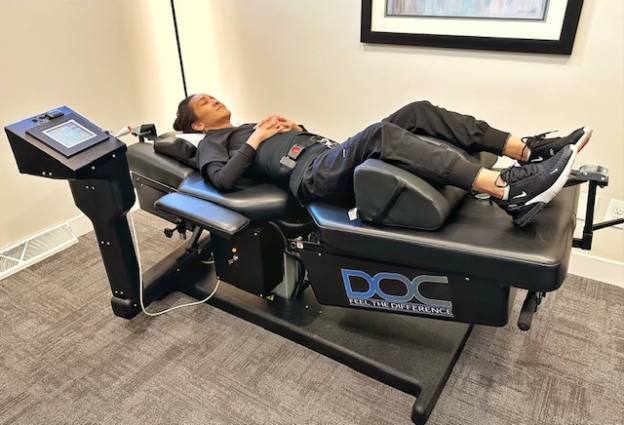Back pain is a debilitating condition affecting millions worldwide. Among the many treatments available, spinal decompression therapy stands out as a highly effective solution. This non-invasive therapy has been gaining popularity for its ability to provide long-lasting relief. In this article, we will delve into the intricacies of spinal decompression therapy, exploring how it works, its benefits, and why it could be the answer to ending your back pain for good.
Understanding Spinal Decompression Therapy
Spinal decompression therapy is a non-surgical, traction-based treatment aimed at relieving pressure on the spine and promoting healing. It involves gently stretching the spine, which changes its force and position. This process helps take pressure off the spinal discs, which are gel-like cushions between the bones in your spine. By reducing the pressure, spinal decompression allows bulging or herniated discs to retract, taking pressure off nerves and other structures in your spine.
How Does Spinal Decompression Therapy Work?
The therapy typically involves the use of a specialized table connected to a computer, which controls the traction force. Patients lie on the table, and a harness is fitted around the pelvis and another around the trunk. The computer then adjusts the table to apply a precise, gentle pull to the spine. This pull helps to create negative pressure within the disc, encouraging the retraction of herniated or bulging discs and facilitating the flow of nutrients, water, and oxygen back into the discs to promote healing.
The Benefits of Spinal Decompression Therapy
- Non-Invasive and Painless One of the primary benefits of spinal decompression therapy is that it is non-invasive. Unlike surgical interventions, there are no incisions or anesthesia required. Patients typically experience a gentle, painless stretching sensation during the treatment.
- Effective Pain Relief Many patients report significant pain relief after just a few sessions of spinal decompression therapy. By alleviating pressure on the spinal discs and nerves, the therapy can reduce pain and discomfort in the back, neck, and even legs.
- Enhanced Mobility and Flexibility Spinal decompression therapy can improve overall spinal health, leading to increased mobility and flexibility. This improvement is particularly beneficial for individuals who have been limited by chronic back pain.
- Promotes Healing By encouraging the flow of essential nutrients and oxygen to the affected discs, spinal decompression therapy promotes natural healing processes within the body. This can lead to longer-lasting relief compared to other pain management techniques.
Who Can Benefit from Spinal Decompression Therapy?
Spinal decompression therapy can be beneficial for a wide range of individuals suffering from various spinal conditions. These include:
- Herniated or Bulging Discs: The therapy can help reduce the protrusion of discs and relieve associated pain.
- Degenerative Disc Disease: Spinal decompression can alleviate pain caused by the wear and tear of spinal discs.
- Sciatica: The therapy can reduce the pressure on the sciatic nerve, alleviating pain that radiates from the lower back down to the legs.
- Spinal Stenosis: By creating more space within the spinal canal, spinal decompression can relieve symptoms of spinal stenosis.
The Spinal Decompression Therapy Procedure
A typical back decompression session lasts between 30 to 45 minutes. Here’s what you can expect during the procedure:
- Initial Assessment Before starting the therapy, a thorough assessment is conducted by a healthcare professional. This includes a review of your medical history, a physical examination, and possibly imaging tests such as X-rays or MRIs to determine the extent of spinal issues.
- Treatment Plan Based on the assessment, a customized treatment plan is developed. The plan outlines the number of sessions required, the duration of each session, and specific goals for pain relief and mobility improvement.
- Therapy Sessions During each session, you will lie on a motorized table. The harnesses will be fitted, and the table will be adjusted to apply the decompression force. The computer system ensures that the force is applied precisely and gradually, avoiding any sudden or uncomfortable movements.
- Post-Treatment Care After each session, patients may undergo additional therapies such as electrical stimulation, ultrasound, or cold therapy to enhance the benefits of spinal decompression. Specific exercises and stretches may also be recommended to support spinal health.
Potential Risks and Considerations
While spinal decompression therapy is generally safe, it’s essential to consider potential risks and discuss them with your healthcare provider. These may include:
- Mild Discomfort: Some patients may experience mild discomfort during or after the sessions, which usually subsides quickly.
- Contraindications: The therapy may not be suitable for individuals with certain conditions such as advanced osteoporosis, fractures, tumors, or infections in the spine.
Conclusion
Spinal decompression therapy offers a promising solution for individuals suffering from chronic back pain. Its non-invasive nature, combined with its effectiveness in promoting healing and pain relief, makes it a valuable option for many. By understanding how spinal decompression therapy works and who can benefit from it, you can make an informed decision about whether this treatment is right for you. If you’re tired of living with back pain, spinal decompression therapy might be the answer to ending your discomfort for good.




